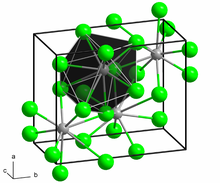
Back Bariumchloried AF كلوريد الباريوم Arabic Barium xlorid AZ کولورید باریوم AZB Clorur de bari Catalan Chlorid barnatý Czech Bariumchlorid German Χλωριούχο βάριο Greek Baria klorido EO Cloruro de bario Spanish

| |

| |
| Names | |
|---|---|
Other names
| |
| Identifiers | |
| |
3D model (JSmol)
|
|
| ChemSpider | |
| ECHA InfoCard | 100.030.704 |
| EC Number |
|
PubChem CID
|
|
| RTECS number |
|
| UNII |
|
| UN number | 1564 |
CompTox Dashboard (EPA)
|
|
| |
| |
| Properties | |
| BaCl2 | |
| Molar mass | 208.23 g/mol (anhydrous) 244.26 g/mol (dihydrate) |
| Appearance | White powder, or colourless or white crystals (anhydrous) Colourless rhomboidal crystals (dihydrate)[2][3] |
| Odor | Odourless |
| Density | 3.856 g/cm3 (anhydrous) 3.0979 g/cm3 (dihydrate) |
| Melting point | 962 °C (1,764 °F; 1,235 K) (960 °C, dihydrate) |
| Boiling point | 1,560 °C (2,840 °F; 1,830 K) |
| |
| Solubility | Soluble in methanol, insoluble ethyl acetate, slightly soluble in hydrochloric acid and nitric acid, soluble in ethanol.[4][3] The dihydrate of barium chloride is soluble in methanol, almost insoluble in ethanol, acetone and ethyl acetate.[3] |
| −72.6·10−6 cm3/mol | |
| Structure | |
| PbCl2-type orthorhombic (anhydrous) monoclinic (dihydrate) | |
| Thermochemistry | |
Std molar
entropy (S⦵298) |
123.9 J/(mol·K) |
Std enthalpy of
formation (ΔfH⦵298) |
−858.56 kJ/mol |
| Hazards | |
| Occupational safety and health (OHS/OSH): | |
Main hazards
|
Highly toxic, corrosive |
| GHS labelling: | |

| |
| Danger | |
| H301, H302, H332 | |
| P261, P264, P270, P271, P301+P310, P304+P312, P304+P340, P312, P321, P330, P405, P501 | |
| NFPA 704 (fire diamond) | |
| Flash point | Non-flammable |
| Lethal dose or concentration (LD, LC): | |
LD50 (median dose)
|
78 mg/kg (rat, oral) 50 mg/kg (guinea pig, oral)[6] |
LDLo (lowest published)
|
112 mg/kg (as Ba) (rabbit, oral) 59 mg/kg (as Ba) (dog, oral) 46 mg/kg (as Ba) (mouse, oral)[6] |
| NIOSH (US health exposure limits): | |
PEL (Permissible)
|
TWA 0.5 mg/m3[5] |
REL (Recommended)
|
TWA 0.5 mg/m3[5] |
IDLH (Immediate danger)
|
50 mg/m3[5] |
| Safety data sheet (SDS) | NIH BaCl |
| Related compounds | |
Other anions
|
|
Other cations
|
|
| Supplementary data page | |
| Barium chloride (data page) | |
Except where otherwise noted, data are given for materials in their standard state (at 25 °C [77 °F], 100 kPa).
| |
Barium chloride is an inorganic compound with the formula BaCl2. It is one of the most common water-soluble salts of barium. Like most other water-soluble barium salts, it is a white powder, highly toxic, and imparts a yellow-green coloration to a flame. It is also hygroscopic, converting to the dihydrate BaCl2·2H2O, which are colourless crystals with a bitter salty taste. It has limited use in the laboratory and industry.[7][3]
- ^ Chemical Recreations: A Series of Amusing and Instructive Experiments, which May be Performed with Ease, Safety, Success, and Economy ; to which is Added, the Romance of Chemistry : An Inquiry into the Fallacies of the Prevailing Theory of Chemistry : With a New Theory and a New Nomenclature. R. Griffin & Company. 1834.
- ^ "Barium Chloride - an overview | ScienceDirect Topics".
- ^ a b c d "Barium chloride".
- ^ Handbook of Chemistry and Physics, 71st edition, CRC Press, Ann Arbor, Michigan, 1990.
- ^ a b c NIOSH Pocket Guide to Chemical Hazards. "#0045". National Institute for Occupational Safety and Health (NIOSH).
- ^ a b "Barium (soluble compounds, as Ba)". Immediately Dangerous to Life or Health Concentrations (IDLH). National Institute for Occupational Safety and Health (NIOSH).
- ^ Kresse, Robert; Baudis, Ulrich; Jäger, Paul; Riechers, H. Hermann; Wagner, Heinz; Winkler, Jocher; Wolf, Hans Uwe (2007). "Barium and Barium Compounds". In Ullman, Franz (ed.). Ullmann's Encyclopedia of Industrial Chemistry. Wiley-VCH. doi:10.1002/14356007.a03_325.pub2. ISBN 978-3527306732.
